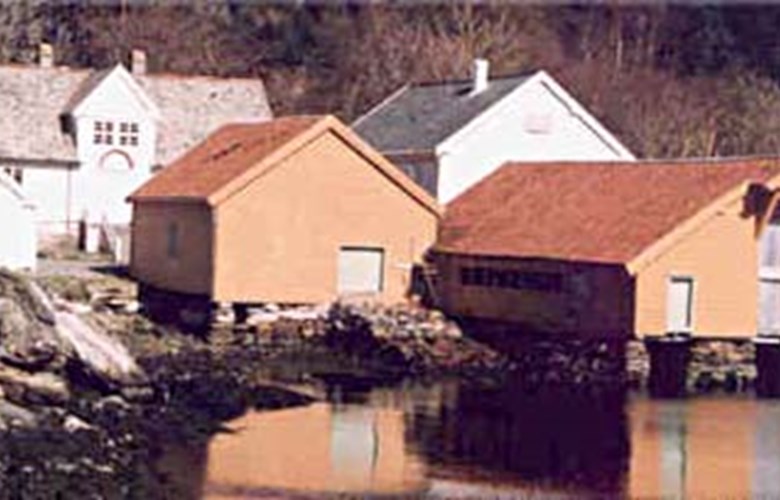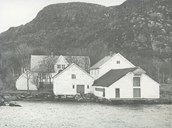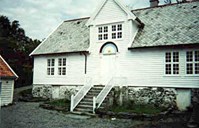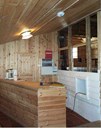Ideal location for the fish trade.
Vågsberget was originally a holding under the farm of Våge, but in the 18th century it was registered as a separate farm. Vågsberget became a trading post in the early 17th century. The place is close to the ocean and the location was ideal in relation to the fishery grounds of the bays of Kvalheimsvika and Torskangerpollen. These were the best grounds in the area for the winter cod fisheries. Nearly on an annual basis, huge shoals of cod came to these bays, and people from all over the region of Nordfjord came to participate in these fisheries.
The development of the trading post
In 1636, there is a record of the trade citizen Didrik Fester from Bergen as a so-called "udliggerborger" at Berget (may be explained as an itinerant trade citizen who paid taxes where he had his citizenship, in this case Bergen). However, the trading post is most likely older than that. There is reason to believe that the owner of the farm Våge ran a trading post and inn before Fester came to Vågsberget. We have little detailed knowledge of Fester's trading activities. At his death in 1675, his wife Cathrine and their two children, Aleksander and Margrethe, inherited the place, valued at 200 "riksdaler". The widow and the son continued the trade. In 1692, Aleksander D. Fester was granted a royal permission to carry out trade at Vågsberget. In addition, he represented the Crown in collecting the so-called "consumption tax". According to court records, Fester bought birds' eggs, hides, butter, tallow and fish from the farmers. He sold malt, tobacco, liquor, as well as other commodities. When Aleksander D. Fester died in 1695, his widow, Karen Jensdotter Rafn, took over the trade. She also ran the inn at Måløyna. In the 1701 census, we find her name and those of her five sons. Besides, she had three daughters. Karen Rafn remarried in 1704 and the name of her new husband was Jakob O. Lammetun.
Modesta Fester, mother and daughter
Lammetun took over the operation of the businesses both at Vågsberget and Måløy. In 1735, he sold everything to Karen R. Lindgaard, the daughter of Karen Rafn's brother. Two years earlier she had been granted the privilege of carrying out trade and keeping an inn. Karen Lindgaard did not stay long in the business, however, because in 1740, she transferred by deed the trading post to Modesta, the youngest daughter of Aleksander Fester and Karen Rafn. Modesta Fester did not only take over the trading post and privilege at Vågsberget, but also the inn at Måløyna, the farms of Våge, Holevik, Færestrand,, Husevåg and "Gautestrand", as well as parts of the farms of Vetvik, Indre Grotle and Reksta. She became a widow at an early age, and in 1744, she sold everything to her daughter Karen Kristine. But it was one of her other daughters who came to operate the businesses at Vågsberget. She had the same name as her mother, Modesta Fester. In 1751, she married Peder P. Bang.
In 1757, it was recorded that the trading post of Vågsberget was vital for the general public, particularly in winter when a substantial number of people from Nordfjord tried to make enough money to pay their taxes and eke out a living by taking part in the fisheries there.
Peder P. Tonning
About 1770, Peder P. Tonning (1738-1811) bought Vågsberget, and, in 1777, he got the trading permit and in 1779, the permit to keep an inn. Tonning was a son of the bailiff Peder Tonning and a brother of the shopkeeper Ole Tonning in Stryn.
In 1801, 21 persons lived at Vågsberget. Peder Tonning was 63 years old and remarried to the widow Anne Laurentze Nagel Leganger. Three of her daughters lived there and also Hans Høegh, brother of Tonning's first wife. Eight servants belonged to the household, three of them were enlisted seamen. A painter and two cottager families, consisting of two and three family members respectively, constituted the remainder of the Vågsberget population.
Peder Tonning is said to have torn down some of the old buildings at Vågsberget and replaced them with new ones. The main building at Vågsberget today is said to have been built by Tonning in 1810. A warehouse, the shop, a cottage for the servants, farmhands and visitors, an "eldhus" (a multi-purpose cottage used mostly for baking and washing clothes) were supposedly built in the same year.
Peder Tonning leased several sites for warehouses at Torskangerpollen. These were called "ocean cottages", a convenient arrangement for the many fishermen who came from far-away places to take part in the seasonal fisheries there. Tonning himself also took active part in these fisheries with a fleet of several fishing vessels, even with a fully rigged boom-sail "jekt".
Tonning frequently had quarrels with the trader at Måløyna concerning the monopoly of the trade along the strait of Ulvesundet and Vågsfjorden.
Johanne Marie Ravn
In 1812, Hans Seehus Bronchorst (1765-1824) from Bergen got the lease for Vågsberget. He was master of the pilot guild, trader at Vågsberget, as well as manager of the so-called hospital estate in Nordfjord. Bronchorst probably worked for Tonning before he took over, and he continued the practice of leasing sites for "ocean cottages". At Bronchorst's death in 1824, Daniel Johan Ravn took over the business. He was born at Gjerde in Eid and was married to one of the Bronchorst daughters, Johanne Marie. In fact, she was the one who ran the trading post, because Ravn died in 1830, at the early age of 34. Mrs Ravn was reputed to have been an enterprising woman, commanding respect from all quarters. Every year she sailed the "jekt" to Bergen with dried and salted fish, as well as other commodities, bought and returned supplies for the coming year for her trading post. She put an end to the sale of liquor, even if this was highly profitable, because she realized that this part of the trade was not a blessing for the local community.
The final years of Vågsberget as a trading post
In 1836, Mrs Ravn sold Vågsberget to Christopher Lausen Berg, senior (1772-1861) for 3500 "riksdalar". He took over as trader and master of the pilot guild after Bronchorst. His son, Christopher Lausen Berg, junior (1810-1878), was given a lease of the property and chattels in 1841, and took over as master of the pilot guild. This office was terminated there when Berg died in 1878. His widow continued the trade and the operation of the farm until 1889, when she sold everything and moved to Nordfjordeid.
The place was now bought by the manager of the telegraph station P. A. Strømme and the bailiff Arnoldus Lem. The trading post no longer had the extra income from the management of the hospital estate or being master of the pilot guild. These two new owners did not take active part in the running of the trading post, but had tenants or employed people to run the business. In 1897, Strømsøe's part was leased to Lem.
The trade from the grocery shop gradually declined and came to an end about the turn of the century. Part of the explanation for the decline of the trade at Vågsberget may be the competition with the new grocery shop at Vågsvåg. Vågsvåg had a more convenient location and was situated less than half a kilometre from Vågsberget. As early as 1869, a grocery shop was established there, followed by an inn in 1871. Later on post office, telephone exchange, and shipping agent's office were established.
Fishmeal factory
In 1900, Einar Lem started a fish business at Vågsberget which he ran until 1915. His brother, Rolf, then took over the business. Shortly afterwards, Rolf Lem started a limited company with two of his brothers, and Rolf was the general manager of the company.
In 1920, the seafood business at Vågsvåg was bought by the shipowner Jacob Kjøde. In 1928, he converted the business into production facilities for fishmeal, fox feed, various types of processed herring as well as canned seafood under the name of AS Vaagsberg (Ltd.). Later on his son-in-law Johan Horn took over as managing director. In the early 1950s, the company employed about 100 workers. During the herring fishery in 1952, about 100 000 hectolitres of herring were processed.
The buildings
At present there are seven buildings at Vågsberget. The elegant residence is a big building on one-and-a-half floors with a pointed dormer and a symmetrical façade. The house served as a residence for the owner until 1959. In front of this house we find the following buildings: a warehouse, a cottage for the servants and the farmhands, and an "eldhus" (see explanation above). The servants' cottage rises two-and-a-half floors, and the oldest part probably dates from 1772. The shop also served as a boathouse, workshop, storage room, and a prison. This building has a cog-joint framework with an external gallery along the side walls. The warehouse is a timber frame house, and parts of one of the walls are linked to the shop. On the eastern side of the main residence is a fine rectangular garden encircled by a stone wall, and behind the house we find the storehouse and the outbuilding.
The main building dates from 1810, showing the lifestyle of the proprietor, whereas the servants' cottage shows how the servants and travellers lived. All the buildings in their own way testify to the work and working conditions of the people who lived at Vågsberget.
Oilbase?
In the 1970s, the municipality of Vågsøy took over the management of Vågsberget with a view of preserving the old buildings. When the "oil fever" was raging in the 1970s, and the coastal municipalities fought hard to get the oil bases on land, the Vågsøy municipality offered Vågsberget as a site for an oil base - without any success.
It might be of interest to know that in 1987, Vågsberget was used as a location for the shooting of the film "Vagabonds", based on the novel written by Knut Hamsun. The play "The Days of Sunniva" by Rolf Losnegård was first performed in 1978. In the summer of 2000, this play was staged at the Vågsberget Open-air Theatre.
Restoration work under the auspices of the Coastal Museum
In May, 1989, the decision by the Vågsøy municipal council to buy the old trading post at Vågsberget was sanctioned by the County Governor. It was decided that the Coastal Museum of Sogn og Fjordane would take over the responsibility of the management of the property. The Museum started drawing up a plan for the repair and restoration of the place. The museum wanted to create a living culture and museum centre at Vågsberget.
On Thursday, 21 September the same year, the local paper "Firdaposten" reported that the restoration work was under way. Eight persons were then working full time on the project, under the guidance of the curator Bjørn Fjellheim at the Coastal Museum. The old warehouse was the first building to be restored. A further restoration plan was being worked out. Protection through use was the central idea in the plan.
In the 1990s, however, it turned out that the restoration work progressed slowly, both due to lack of resources and labour. The project was given money from various institutions and foundations, but in sum these contributions were far from enough. Allocations from the Norwegian Regional and Industrial Development Fund as well as contributions from local businesses were non-existent. In late 1999, about six million kroner had been spent on the restoration, rehabilitation and modernization of the buildings, but the project lacked four million to complete the work.
Status in early 2002
Today's status is that the warehouse, the shop, and the storage house are fully restored. The inn, also called the servants' cottage, is planned to be used for accommodation. The exterior of the inn building is restored and a sprinkler system has been installed indoors. However, there are no means to finance a modern interior, electric installations, and kitchen fittings, appliances and utensils. The exterior of the "eldhus" is also completely restored. There are plans to install shower cubicles in this building.
The outbuilding has been rebuilt, now containing meeting rooms, gallery, café, and other rooms as well. A modern kitchen has not yet been installed. The building was taken into use in the summer of 2000. It has so far been used for art exhibitions, weddings, cultural heritage days, and a number of other activities. In the same summer guided tours were started at Vågsberget.
In the spring of 2002, restoration of the main building is planned to get under way. Out of the seven buildings at Vågsberget, this was the building that was best preserved when the restoration work was started in 1989. The first project is to repair the roof, and then the outer walls will be restored. Later on, the interior redecoration work will begin.







